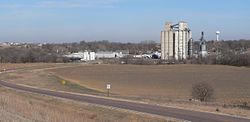2010 census
As of the census [8] of 2010, there were 590 people, 204 households, and 147 families living in the village. The population density was 2,107.1 inhabitants per square mile (813.6/km2). There were 218 housing units at an average density of 778.6 units per square mile (300.6 units/km2). The racial makeup of the village was 89.8% White, 0.2% African American, 1.2% Native American, 0.7% Asian, 6.8% from other races, and 1.4% from two or more races. Hispanic or Latino of any race were 9.0% of the population.
There were 204 households, of which 45.6% had children under the age of 18 living with them, 58.8% were married couples living together, 9.3% had a female householder with no husband present, 3.9% had a male householder with no wife present, and 27.9% were non-families. 23.5% of all households were made up of individuals, and 13.3% had someone living alone who was 65 years of age or older. The average household size was 2.73 and the average family size was 3.31.
The median age in the village was 34.2 years. 32.2% of residents were under the age of 18; 4.9% were between the ages of 18 and 24; 28.9% were from 25 to 44; 15.6% were from 45 to 64; and 18.3% were 65 years of age or older. The gender makeup of the village was 51.4% male and 48.6% female.
2000 census
As of the census [3] of 2000, there were 564 people, 192 households, and 139 families living in the village. The population density was 1,852.5 inhabitants per square mile (715.3/km2). There were 200 housing units at an average density of 656.9 units per square mile (253.6 units/km2). The racial makeup of the village was 98.76% White, 0.18% African American, 0.35% Native American, 0.18% Asian, 0.18% from other races, and 0.35% from two or more races. Hispanic or Latino of any race were 0.18% of the population.
There were 192 households, out of which 41.1% had children under the age of 18 living with them, 64.6% were married couples living together, 6.3% had a female householder with no husband present, and 27.1% were non-families. 22.9% of all households were made up of individuals, and 13.0% had someone living alone who was 65 years of age or older. The average household size was 2.67 and the average family size was 3.15.
In the village, the population was spread out, with 26.8% under the age of 18, 7.3% from 18 to 24, 30.3% from 25 to 44, 11.2% from 45 to 64, and 24.5% who were 65 years of age or older. The median age was 35 years. For every 100 females, there were 91.2 males. For every 100 females age 18 and over, there were 91.2 males.
As of 2000 the median income for a household in the village was $41,944, and the median income for a family was $52,083. Males had a median income of $34,375 versus $24,875 for females. The per capita income for the village was $20,471. About 5.6% of families and 6.4% of the population were below the poverty line, including 10.7% of those under age 18 and 13.8% of those age 65 or over.


